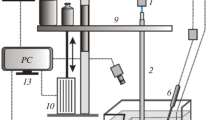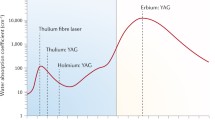Abstract
Breaking of optical fibre tips during medical holmium laser applications involving endoscopic irradiation in a liquid environment, such as arthroscopy, has been reported. This represents a risk of complications due to foreign body reactions induced by quartz fragments remaining at the operation site.
Fibre breakage has been analysed under controlled conditions at clinically used laser energies of 20–1000 mJ. The generation of pressure transients at the collapse of laser-induced vapour bubbles is identified as the mechanism of fibre tip destruction. Fibre damage is observed only in a confining liquid envivronment. The highest fibre damage occurrence is observed for laser fluences of 70–250 J cm-25 at the bare fibre tip, at pulse durations of 200–350 Μs. The fibre damage occurrence and extent increase with the fibre diameter.
Avoiding the identified dangerous fluence range or use of fibres smaller than 400Μm diameter is recommended to perform endoscopic holmium laser application with minimal fibre damage risk.
Similar content being viewed by others
References
Möller KO, Lind BM, Karcher K, Hohlbach G. Holmium Laser versus mechanische Knorpelabtra-gung. Vergleichende Untersuchung am Arthrosemodell bei Kaninchen.Langenbecks Arch Chir 1994,379:84–94
Dorn U.Laserarthroskopie am Kniegelenk des Deut- schen Landschweins. MD Thesis (Dr. der VeterinÄ- medizin). Freie UniversitÄt Berlin, 1994 (unpubl.)
Rink K, Delacrétaz G, Salathé RP. Fragmentation process of current laser lithotriptors.Lasers Surg Med 1995,16:134–46
Thomas S, Pensel J, Engelhardt R, Meyer W, Hofstetter A. The pulsed dye laser versus Q-switched Nd:YAG laser in laser induced shockwave lithotripsy.Lasers Surg Med 1988,8: 363–70
Bruhn EW, Go P, McClane RW, Hunter JG, Straight RC. Biological consequences of fiber fragmentation with pulsed laser lithotripsy. In:Laser Surgery: Advanced Characterization, Therapeutics, and Systems II. Los Angeles, 1990.Proc. SPIE 1200:90–3
Brinkmann R, Meyer W, Engelhardt R, Walling JC. Laser induced shockwave lithotripsy by use of an 1 Μs Alexandrite laser. In:Laser Surgery: Advanced Characterization, Therapeutics, and Systems II. Los Angeles, 1990.Proc. SPIE 1200:67–74
Strunge C, Brinkmann R, Flemming G, Engelhardt R. Interspersion of fragmented fiber’s splinters into tissue during pulsed alexandrite laser lithotripsy.Lasers Surg Med 1991,11:183–7
Rink K, Delacrétaz G, Salathé RP. Fragmentation process induced by nanosecond laser pulses.Appl Phys Lett 1992,61:2644–6
Rink K, Delacrétaz G, Salathe RP. Fragmentation process induced by microsecond laser pulses during lithotripsy.Appl Phys Lett 1992,61:258–60
van Leeuwen TG, van der Veen MJ, Verdaasdonk RM, Borst C. Noncontact tissue ablation by holmium:YSGG laser pulses in blood.Lasers Surg Med 1991,11:26–34
Asshauer T, Rink K, Delacrétaz GP et al. Acoustic transient generation in pulsed holmium laser ablation underwater. In:Laser-Tissue Interaction V. Los Angeles, 1994.Proc. SPIE 213A:423–33
Asshauer T, Rink K, Delacrétaz G. Acoustic transient generation by holmium laser induced cavitation bubbles.J Appl Phys 1994,76:5007–13
Blake JR, Taib BB, Doherty G. Transient cavities near boundaries. Part 2. Free surface.J Fluid Mech 1987,181:197–212
Plesset MS. Shock waves from cavity collapse.Philos Trans Roy Soc London A1966,260: 241–4
Tschepe J, Gundlach P, Hopf J, Leege N, Müller G, Scherer H. Faserabbrand beim Alexandrit-Laser: ein Problem der laserinduzierten Stosswellen Lithotripsie.Lasermedizin 1991,7: 162–6
Brennen CE.Cavitation and Bubble Dynamics. Oxford: Oxford University Press, 1995 (Oxford Engineering Series 44)
Asshauer T, Jansen ED, Frenz M, Delacrétaz G, Welch AJ. Acoustic transients in pulsed holmium laser abla- tion: Effects of pulse duration. In:Laser Interaction with Hard and Soft Tissue II. Lille, 1994.Proc. SPIE 2323:117–29
Jansen ED, Asshauer T, Frenz M, Motamedi M, Delacrétaz G, Welch AJ. Effect of pulse duration on bubble formation and laser-induced pressure waves during holmium laser ablation.Lasers Surg Med 1996,18:278–93.
Author information
Authors and Affiliations
Rights and permissions
About this article
Cite this article
Asshauer, T., Delacrétaz, G. Analysis of fibre tip damage risk during pulsed holmium laser application under water. Laser Med Sci 12, 157–163 (1997). https://doi.org/10.1007/BF02763986
Received:
Accepted:
Issue Date:
DOI: https://doi.org/10.1007/BF02763986




